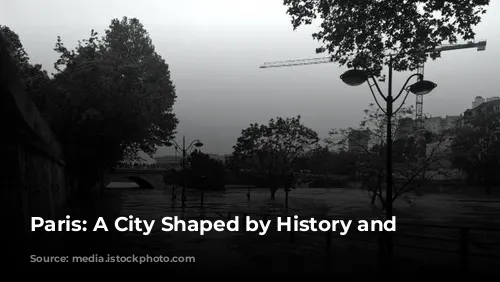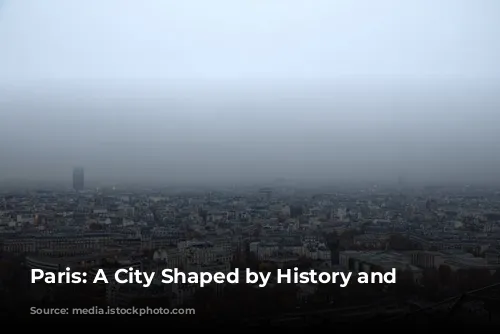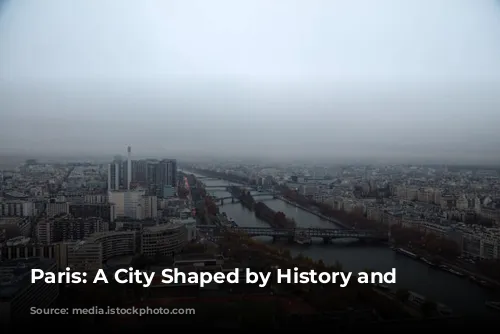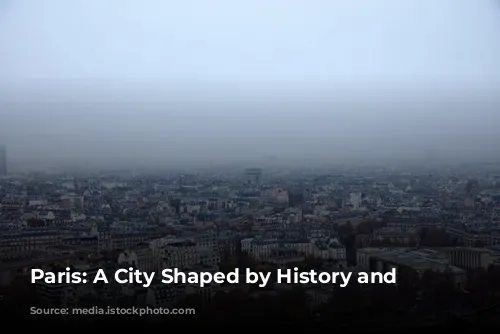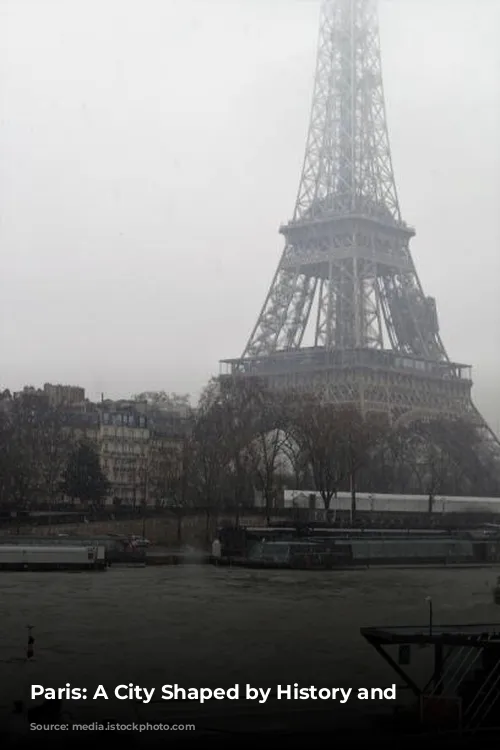Nestled on the western edge of Europe, Paris enjoys a pleasant climate thanks to the Gulf Stream’s gentle influence. However, the weather can be unpredictable, especially during the colder months, when chilly winds sweep across the city. Despite these fluctuations, the average temperature remains comfortable, with July being the warmest month at around 19°C and January the coolest at about 3°C. While the city experiences freezing temperatures for approximately a month each year, snowfall graces Paris only on about half of those days. To ensure the well-being of its residents, Paris has taken steps to curb air pollution and purify its water supply, making tap water safe for consumption.
Over the centuries, Paris has expanded outward from its historical heart, the Île de la Cité, and has undergone various transformations as it grew. To protect its burgeoning population, walls were erected to enclose different parts of the city. After a devastating barbarian attack on the Roman town on the Left Bank in the 3rd century, the fire-damaged stones were transported to the Île de la Cité to build a defensive wall. Over time, this wall was rebuilt several times, serving as a vital shield during periods of conflict. The earliest bridge connecting the Left Bank to the Île de la Cité, the Petit Pont, was also fortified with a gate, the Petit Châtelet, which provided added security. On the other side of the river, the Pont au Change, the bridge leading to the Right Bank, was guarded by the imposing Grand Châtelet, a structure that served as a fort, prison, torture chamber, and morgue until its demolition in 1801.
From Walls to Boulevards: Shaping the City
Under King Philip II’s reign, between 1180 and 1225, a new wall was built to encompass the settlements on both banks of the Seine. This defensive structure was further expanded by Charles V between 1367 and 1370, with the formidable Bastille fortress guarding the eastern approaches and the Louvre fortress protecting the western side of the city. In 1670, Louis XIV ordered the Charles V walls to be replaced by the tree-lined Grands Boulevards, which were embellished with triumphal arches at the Saint-Denis Gate and the Saint-Antoine Gate. The Saint-Denis arch still stands proudly today. The word “boulevard,” derived from “bulwark,” originally referred to a military defensive wall’s platform. Today, the Grands Boulevards, reminiscent of the arch of the river, stretch from the Place de la Madeleine in the north and east to the Place de la République.
In the latter half of the 18th century, a new wall was built with 57 tollhouses. These tollhouses, which still stand at the Place Denfert-Rochereau, enabled tax collectors to impose customs duties on goods entering Paris. The last wall, constructed in the mid-19th century by Adolphe Thiers for King Louis-Philippe, was a truly formidable military installation with outlying forts. This wall, upon its completion, encompassed a number of hamlets outside Paris, including Auteuil, Passy, Montmartre, La Villette, and Belleville.
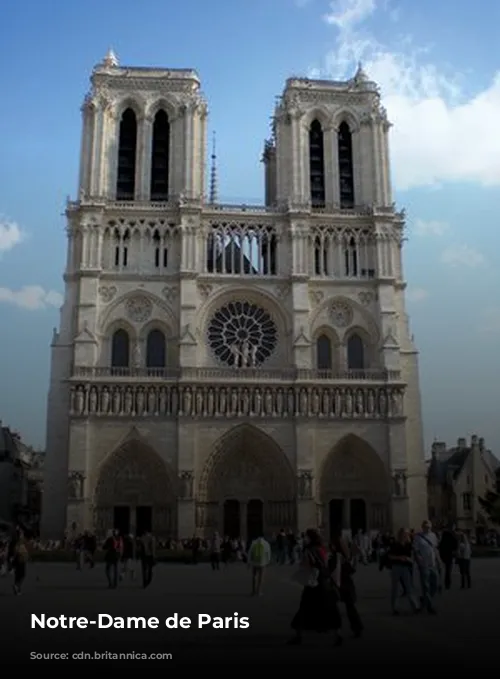
A City in Transformation
The rebuilding efforts and economic recovery following the collapse of Napoleon III’s Second Empire in 1870, coupled with the Industrial Revolution’s growing job market, attracted a wave of people to Paris, especially with the advent of railway systems. Between 1852 and 1870, the city planner Baron Haussmann tore down the walls of the farmers-general and constructed a series of wide, straight boulevards, cutting through the city’s labyrinth of narrow streets. The 19th-century walls were eventually demolished, and the boulevards were extended in 1925.
Today, Paris is renowned for its majestic cityscapes, a harmonious blend of boulevards, ancient buildings, monuments, gardens, plazas, and bridges. In 1991, a significant part of central Paris was recognized as a UNESCO World Heritage site, signifying its cultural and historical importance.
The Île de la Cité: The Heart of Paris
In the heart of Paris, the Île de la Cité, a ship-shaped island nestled in the Seine, is the historical heart of the city. This island, measuring approximately 10 streets in length and 5 in width, is connected to the riverbanks by eight bridges, with a ninth leading to the smaller Île Saint-Louis. The westernmost bridge, the Pont Neuf, built between 1578 and 1604, despite its name, is actually the oldest surviving bridge in Paris. Its sturdy construction is legendary, with Parisians often using the phrase “solid as the Pont Neuf” to describe something durable. The bridge, supported in the middle by the tip of the island, extends five arches to the Left Bank and seven to the Right. The parapet corbels are adorned with over 250 unique grotesque masks, adding a touch of whimsical character. The parapet curves outwards towards the water at each bridge pier, forming half-moon bays that served as the first sidewalks in Paris and provided space for street vendors to set up their shops. For 200 years, this bridge served as the main street and bustling marketplace of Paris. While the Pont Neuf undergoes regular maintenance, the original structure remains largely intact, a testament to its enduring strength.
Just downstream from the Pont Neuf, the tip of the Île de la Cité transforms into a triangular park, with gravel paths, flowering bushes, and benches beneath ancient trees. The park is surrounded by a wide, cobblestone quay, a popular spot for sunbathers and lovers. At the base of the steps leading onto the bridge from the park stands a bronze equestrian statue of King Henry IV, who championed the completion of the Pont Neuf. This statue, a 1818 replica of the 1614 original, was the first statue to grace a public space in Paris. Opposite the statue is the narrow entrance to the Place Dauphine (1607), named after Henry IV’s heir, the future Louis XIII. This square, once a triangle of uniform red-brick houses accented with white stone, lost its row of houses along the base in 1871 to make way for the construction of a portion of the Palace of Justice.
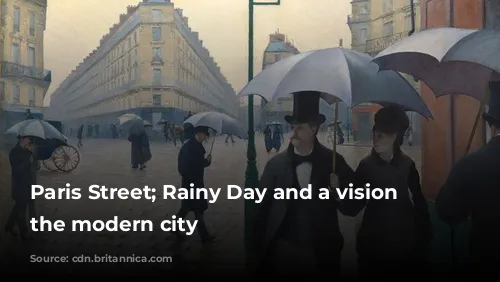
A Tapestry of History: The Palace of Justice and the Sainte-Chapelle
The Palace of Justice, standing on the site of the early Roman governor’s palace, was rebuilt by King Louis IX (St. Louis) in the 13th century and expanded 100 years later by Philip IV (the Fair), who added the imposing Conciergerie, with its impressive Gothic chambers. The Great Hall, once the meeting place of the Parlement, the high court of justice under the kings, was renowned throughout Europe for its Gothic beauty. Sadly, fires in 1618 and 1871 ravaged the original room, and much of the rest of the palace was devastated by flames in 1776. Today, the Great Hall serves as a waiting room for the various courts housed within the Palace of Justice. In the adjoining first Civil Chamber, the Revolutionary Tribunal held its court in 1793, condemning approximately 2,600 individuals to the guillotine. After sentencing, the victims were led down the stone stairs to the Conciergerie dungeons, where they awaited their fate in tumbrels, carts that transported them to the execution site. The Conciergerie, still standing today, is open to visitors, offering a chilling glimpse into France’s turbulent past.
Within the palace courtyards stands one of France’s most treasured monuments, the 13th-century Sainte-Chapelle. Constructed at Louis IX’s behest between 1243 and 1248, the chapel is a masterpiece of Gothic Rayonnant style. With breathtaking audacity, the architect, possibly Pierre de Montreuil, balanced the vaulted ceilings on a delicate trellis of slender columns, with the walls between crafted from stained glass. This exquisite chapel was designed to house the Crown of Thorns, believed to be the very one worn by Jesus during his crucifixion. Louis IX acquired the relic from the Venetians, who held it in pawn from Baldwin II Porphyrogenitus, the Latin emperor of Constantinople. Other holy relics, including nails and pieces of wood from the True Cross, were added to the chapel’s collection, remnants of which are now housed in the treasury of Notre-Dame.
A City Reborn: Renewal and Modernization
Under King Louis-Philippe in the 19th century, the island underwent a major “sanitization” project, continued under his successor, Napoleon III, by Baron Haussmann. This comprehensive undertaking involved the clearance of outdated structures, the widening of streets and squares, and the construction of grand new government offices, including sections of the Palace of Justice. The section of the palace bordering the Quai des Orfèvres, formerly the goldsmiths’ and silversmiths’ quay, became the headquarters of the Paris municipal detective force, the Police Judiciaire. Across the boulevard du Palais is the Police Prefecture, another 19th-century structure. On the far side of the prefecture, the Place du Parvis-Notre-Dame, an open space enlarged sixfold by Haussmann, replaced the Hôtel-Dieu, the first hospital in Paris, which was relocated to the inland side of the square. The current buildings of the Hôtel-Dieu date back to 1868.
Paris, a city steeped in history and woven with the threads of time, continues to captivate visitors with its timeless charm and grandeur. From its ancient bridges and monuments to its grand boulevards, Paris offers a glimpse into a rich past and a vibrant present. The city’s enduring spirit is reflected in its remarkable architecture, its art, and its people, making it an irresistible destination for travelers from around the world.
